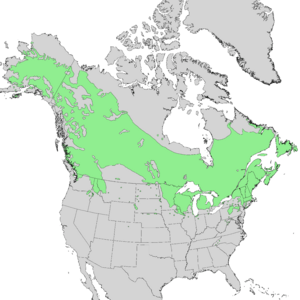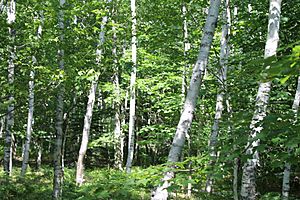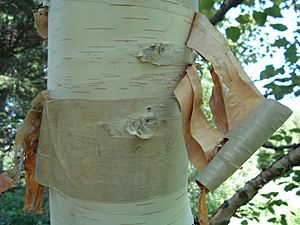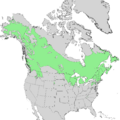Paper birch facts for kids
Quick facts for kids Paper birch |
|
|---|---|
 |
|
| Paper birch forest in Maine | |
| Conservation status | |
| Scientific classification | |
| Genus: |
Betula
|
| Species: |
papyrifera
|
 |
|
| Natural range | |
| Synonyms | |
|
|
The Paper birch (scientific name: Betula papyrifera) is a beautiful tree found in northern North America. People also call it the American white birch or canoe birch. It gets its name from its thin, white bark that peels off in layers, just like paper! Paper birch trees are often the first to grow back after a forest fire. They are also a very important food source for moose. The wood from these trees is often used to make paper and for firewood.
Contents
What Does a Paper Birch Tree Look Like?
Paper birch is a medium-sized deciduous tree. This means it loses its leaves in the fall. It usually grows about 20 meters (66 feet) tall. Some can even reach 40 meters (130 feet)! The trunk can be up to 75 centimeters (30 inches) wide. In forests, it often has one main trunk. But when grown in yards, it might have several trunks or branches close to the ground.
Paper birch trees usually don't live very long. They don't like hot, humid weather. In warmer areas, they might only live for 30 years. But in colder places, they can live for over 100 years! These trees can grow in many different types of soil. They grow best in deep, well-drained soil.
Bark of the Paper Birch
The bark of older paper birch trees is white and very bright. It peels off in thin, horizontal strips. Underneath, the bark is often pink or salmon-colored. You might also see small black marks or scars on it. When the tree is younger than five years old, its bark is reddish-brown. It has white spots called lenticels. This makes it harder to tell apart from other birch trees when they are young.
The bark is very strong and waterproof. It has a lot of oil, which helps it resist weather. Sometimes, if a paper birch tree falls, the wood inside will rot away. But the strong bark will stay hollow and intact!
Leaves and Flowers
The leaves are dark green and smooth on top. The bottom side often has soft hairs on the veins. They grow one after another on the stem. The leaves are oval or triangular, about 5 to 10 centimeters (2 to 4 inches) long. They are about two-thirds as wide as they are long. The base of the leaf is rounded, and the tip is sharply pointed. The edges of the leaves have jagged, sharp teeth. Each leaf has a stem called a petiole, about 2.5 centimeters (1 inch) long.
In the fall, the leaves turn a bright yellow color. This adds to the beautiful colors of the northern deciduous forests. The leaf buds are small and cone-shaped. They are green with brown edges.
The flowers are called catkins. They are pollinated by the wind. The female flowers are greenish and about 4 centimeters (1.5 inches) long. They grow from the tips of the twigs. The male flowers are brownish and about 5 to 10 centimeters (2 to 4 inches) long. The tree flowers from mid-April to June, depending on where it is. Paper birch is monoecious. This means one tree has both male and female flowers.
Seeds and Roots
The fruit of the paper birch ripens in the fall. The fruit has many tiny winged seeds. These seeds are packed between the catkin parts. They fall from September until spring. A tree starts making seeds when it is about 15 years old. It produces the most seeds between 40 and 70 years old.
Seed production is not the same every year. A lot of seeds are usually made every other year. But some seeds are produced every year. In a normal year, about 1 million seeds can be produced per acre. In a very good year, up to 35 million seeds per acre might be made! The seeds are light and can blow far away in the wind. They can also blow along the surface of snow.
The roots of the paper birch are usually shallow. They stay in the top 60 centimeters (24 inches) of the soil. They don't form deep taproots. Because of this, strong winds are more likely to break the tree's trunk than to pull the tree out of the ground.
Where Do Paper Birch Trees Grow?
Betula papyrifera mostly grows in Canada and the very northern parts of the United States. You can find it in Alaska and in almost all parts of provinces and territories of Canada. It also grows in the far northern United States. You can find small groups of these trees as far south as New York and Pennsylvania. They also grow in Washington. Some stands are found high up in the mountains of North Carolina, New Mexico, and Colorado.
Paper Birch in Nature
In Alaska, paper birch often grows by itself in large groups. It can also grow with black or white spruce trees. In the eastern and central parts of its range, it often grows with red spruce and balsam fir. Other trees it might grow with include big-toothed aspen, yellow birch, Betula populifolia, and maples.
Many shrubs also grow near paper birch trees. These include beaked hazel, common bearberry, dwarf bush-honeysuckle, wintergreen, wild sarsaparilla, blueberries, raspberries, elderberry, and hobblebush.
How Paper Birch Helps Forests Grow
Paper birch is a pioneer species. This means it is one of the first trees to grow in an area after a big event. These events could be a wildfire, an avalanche, or a windthrow. A windthrow is when strong winds blow down all the trees. When paper birch grows in these new areas, it often forms groups where it is the only type of tree.
Paper birch trees are good at recovering from fires. They can quickly reseed the area or grow back from the burned tree. Their light seeds are easily carried by the wind to burned areas. There, they quickly sprout and grow into new trees. Paper birch is used to ecosystems where fires happen every 50 to 150 years. For example, it often grows first after a fire in black spruce boreal forests.
Since paper birch is a pioneer species, you don't often find it in very old, mature forests. This is because other trees that like shade more will eventually take over as the forest grows. For example, in Alaskan boreal forests, a paper birch forest might have 3,000 to 6,000 trees per acre 20 years after a fire. But after 60 to 90 years, the number of trees will drop to 500 to 800 per acre. This happens as spruce trees replace the birch. After about 75 years, the birch trees will start to die. By 125 years, most paper birch trees will be gone unless another fire burns the area.
Paper birch trees react differently to wildfires. A group of paper birch trees is not very easy to burn. The leaves often have a lot of water, and the plants under them are usually green and lush. Because of this, fires that burn the tops of conifer trees often stop or slow down when they reach a paper birch forest. Since these forests resist fire, they can become "seed trees." This means they can help reseed the area around them that burned. However, in very dry times, paper birch can burn quickly. Its bark is flammable, so it often burns and can even girdle (kill) the tree.
Wildlife and Paper Birch
Birch bark is a very important winter food for moose. It doesn't have a lot of nutrients, but it's important because there's so much of it. Moose prefer paper birch over aspen, alder, and balsam poplar. However, they like willow more than birch. Even though moose eat a lot of paper birch in winter, they might starve if they only ate paper birch.
White-tailed deer also eat birch, but it's a "secondary choice" food for them. In Minnesota, white-tailed deer eat a lot of paper birch leaves in the fall. Snowshoe hares eat young paper birch trees. Grouse eat the buds. Porcupines and beavers eat the inner bark.
The seeds of paper birch are an important food for many birds and small animals. These include chickadees, redpolls, voles, and ruffed grouse. Yellow-bellied sapsuckers drill holes in the bark of paper birch to get the sap. This is one of their favorite trees to feed on.
How People Use Paper Birch
Paper birch has wood that is moderately heavy and white. It makes excellent firewood if it's dried properly. The dried wood is dense and burns well. Even though paper birch doesn't have a very high economic value overall, it's used for many things. These include furniture, flooring, popsicle sticks, pulpwood (for paper), plywood, and oriented strand board. The wood can also be made into spears, bows, arrows, snowshoes, sleds, and other items.
The sap from the tree can be boiled down to make birch syrup. This sap has less sugar than sugar maple sap. The sap flows later in the season than maple sap. Only a few small businesses in Alaska and Yukon currently make birch syrup from this tree.
Uses of Birch Bark
The bark of the paper birch is a great fire starter. It can catch fire easily even when it's wet! It has a very high energy content.
Panels of bark can be put together or sewn to make containers and boxes. In the Anishinaabe language, a birchbark box is called a wiigwaasi-makak. The bark is also used to make a strong, waterproof layer in houses with sod roofs. Many Indigenous groups, like the Wabanaki peoples, use birchbark to make things like canoes, containers, and wigwams. It's also used as a backing for porcupine quillwork and moosehair embroidery. Thin sheets of bark can even be used for the art of birchbark biting.
Planting Paper Birch
Paper birch is planted to help fix old mines and other damaged areas. Often, young trees are planted without much soil around their roots. Since paper birch is a tough pioneer species, it's a great choice for replanting areas that have been badly disturbed.
When planting paper birch in a yard, don't put it near black walnut trees. Black walnut roots release a chemical called juglone. This chemical is very harmful to paper birch trees.
Paper birch is often planted as an ornamental tree. People like its graceful shape and pretty bark. The bark turns white when the tree is about 3 years old. Paper birch grows best in colder climates. It doesn't like very hot temperatures. For warmer areas, Betula nigra (river birch) is a better choice. Paper birch is also more resistant to a pest called the bronze birch borer than Betula pendula, another tree often planted in yards.
Pests That Affect Paper Birch
The Birch skeletonizer is a small larva that eats the leaves. This causes the leaves to turn brown.
The Birch leafminer is a common pest. It feeds from inside the leaf, making the leaf turn brown. The first group of these insects appears in May, but there can be several groups each year. A lot of these insects can stress the tree. This makes it weaker and more likely to be attacked by the bronze birch borer.
When a tree is stressed, bronze birch borers can kill it. This insect drills into the wood, starting at the top of the tree. This causes the top of the tree to die. The insect leaves a D-shaped hole when it chews its way out of the tree. Healthy trees can fight off this borer. But if a tree is not growing in good conditions, its defenses might not work well. There are chemical ways to control these pests.
Paper Birch in Culture
The paper birch is the official provincial tree of Saskatchewan in Canada. It is also the official state tree of New Hampshire in the United States.
Sometimes, people damage the bark of these trees by carving into it with a knife or peeling off layers. Both of these actions can cause ugly scars on the tree.
Images for kids
-
White birch at Acadia National Park in Maine
See also
 In Spanish: Abedul papirífero para niños
In Spanish: Abedul papirífero para niños













